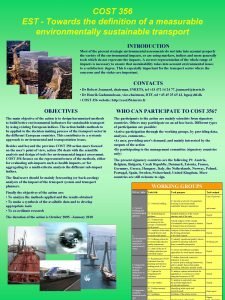COST 356 EST Towards the definition of a

- Slides: 1

COST 356 EST - Towards the definition of a measurable environmentally sustainable transport INTRODUCTION Most of the present strategic environmental assessments do not take into account properly the variety of the environmental impacts, or are using markers, indices and more generally tools which do not represent the impacts. A correct representation of the whole range of impacts is necessary to ensure that sustainability takes into account environmental issues to a satisfactory degree. This is especially important for the transport sector where the concerns and the stakes are important. CONTACTS • Dr Robert Joumard, chairman, INRETS, tel +33 472 14 24 77, joumard@inrets. fr • Dr Henrik Gudmundsson, vice-chairman, DTF, tel +45 45 25 65 43, hgu@dtf. dk • COST 356 website: http: //cost 356. inrets. fr OBJECTIVES The main objective of the action is to design harmonized methods to build better environmental indicators for sustainable transport by using existing European indices. The action builds methods to be applied to the decision making process of the transport sector in the different European countries. This contributes to a systemic approach to environmental and transportation issues. Besides and beyond the previous COST 350 action more focused on the user's point of view, action 356 deals with the scientific analysis and design of tools for environmental impact assessment. COST 356 focuses on the representativeness of the methods, either for evaluating sub-impacts such as health impacts, or for aggregating by a multi-criteria analysis the different sub-impact indices. The final users should be mainly forecasting (or back-casting) analysts of the impact of the transport system and transport planners. Finally the objectives of the action are: • To analyze the methods applied and the results obtained • To make a synthesis of the available data and to develop appropriate tools • To co-ordinate research The duration of the action is October 2005 - January 2010 WHO CAN PARTICIPATE TO COST 356? The participants to the action are mainly scientists from signatory countries. Others may participate on an ad hoc basis. Different types of participation are possible: • Active participation through the working groups, by providing data, analyses, comments. . . • As user, providing user's demand, and mainly interested by the outputs of the action • By participating to the management committee (signatory countries only) The present signatory countries are the following 19: Austria, Belgium, Bulgaria, Czech Republic, Denmark, Estonia, France, Germany, Greece, Hungary, Italy, the Netherlands, Norway, Poland, Portugal, Spain, Sweden, Switzerland, United Kingdom. More countries are still welcome to sign. WORKING GROUPS WG n°, title Task purpose Task output Lists of persons 1. 1. Network building and methodological 1. 2. Methodological guidance 2. Environmental assessment (indicators as measurement tools) 3. Integration in decision making (indicators as decision making tools) 1. 3. Transport and environment in the concept of sustainable development 2. 1. Analysis of the chain of causalities for each environmental impact To develop a network of researchers working on environmentally sustainable transport assessment and events Detailed definition of the Action structure and of the tasks Report Critical analysis of the concept of sustainable development in relation to transport and environment Report Analysis of the chain of causalities from Report the driving parameters to the final impacts 2. 2. Defining criteria for environmental indicator quality assessment To identify operational quality criteria needed for assessing indicators from a scientific perspective Working note 2. 3. State of the art of building indicators per individual impact To review the different scientific approaches for each impact category Report To define functional criteria for 3. 1 Requirements of EST indicators to be used indicators from the in various policy making frameworks, planning and decision and to identify factors that matter making point of view for making indicators actually useful Report 3. 2. Options for integrating EST indicators To analyse options and methods for aggregation, or selection to create integrated measures of EST Report 3. 3. Case studies To analyse in each study case the potential application of relevant indicators Report 4. 1. Further research needs Identifying white spots and research needs 4. Integrative synthesis, 4. 2. Synthesis research needs and Final report Synthesis of the whole Action Papers,

